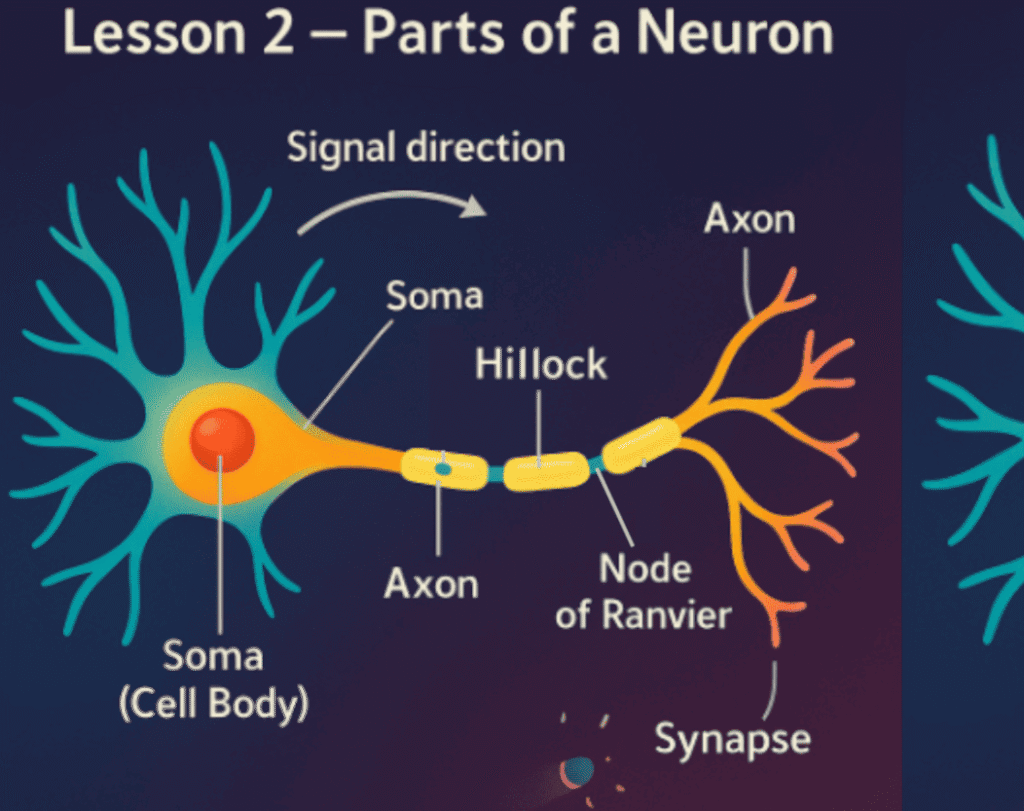🔄 Recap of Lesson 1
In our first lesson, we discovered that the nervous system is the control and communication network of the body. It has two big parts:
-
The central nervous system (CNS): the brain 🧠 and spinal cord 🪢.
-
The peripheral nervous system (PNS): the nerves that spread all over the body.
We learned that signals zoom around the nervous system at lightning speed ⚡, faster than cars and almost like super-fast internet.
Now, let’s ask the big question: What carries those signals?
The answer is: Neurons.
🐜 Step 1: What is a Neuron?
A neuron (pronounced new-ron) is a nerve cell. Just like bricks build a house 🧱, neurons are the basic building blocks of the nervous system.
Your brain alone has about 86 billion neurons. That’s more than the number of stars you can see in the night sky 🌌 with your naked eye!
Each neuron is like a tiny messenger that carries information. But instead of carrying letters like a postman, neurons carry signals in the form of electricity ⚡ and chemicals 🧪.
🔍 Step 2: What Does a Neuron Look Like?

Imagine a tree 🌳 with roots, a trunk, and branches. A neuron looks a bit like that:
-
Dendrites – These are the “branches.” They receive messages from other neurons.
-
Cell Body (Soma) – This is the “trunk.” It holds the nucleus (the command center of the cell).
-
Axon – This is like a long “cable” stretching out from the cell body. It carries the message away.
-
Axon Terminals – These are the “roots” at the end. They pass the message to the next neuron.
Sometimes, the axon is wrapped in a myelin sheath. Think of it as the plastic covering on electrical wires—it makes the signal travel faster and safer.
So, in short:
👉 Dendrites receive.
👉 Cell body decides.
👉 Axon carries.
👉 Terminals deliver.
🎮 Step 3: How Do Neurons Communicate?
Neurons talk to each other in a special language of electricity and chemicals. Let’s break it down:
-
Signal starts – Something triggers the neuron (like touching something hot, or hearing a sound).
-
Electric signal – The neuron sends a small pulse of electricity down the axon. This is called an action potential.
-
Chemical signal – At the axon terminal, the signal changes into chemicals called neurotransmitters.
-
Jumping the gap – These chemicals cross a tiny space called a synapse (the gap between neurons).
-
Next neuron receives – The chemicals land on the next neuron’s dendrites, and the signal continues.
So, neurons are like kids passing secret notes ✉️ in class: one writes it, passes it, the next one reads it, and the chain continues.
🚦 Step 4: Different Types of Neurons
Not all neurons look or act the same. Just like in a city, we have different workers (bus drivers, teachers, doctors), in the nervous system we have different kinds of neurons:
-
Sensory Neurons
These carry messages into the brain and spinal cord. Example: when you touch ice, sensory neurons send “cold” information. -
Motor Neurons
These carry messages out of the brain and spinal cord to muscles. Example: they tell your hand muscles to move. -
Interneurons
These are the connectors. They sit inside the brain and spinal cord and connect sensory neurons to motor neurons.
So:
👉 Sensory neurons = bring in news.
👉 Interneurons = process the news.
👉 Motor neurons = act on the news.
⚡ Step 5: How Fast is a Neuron?
Some neurons can send messages up to 120 meters per second (about 430 km/h). That’s faster than most airplanes at takeoff! 🛫
But not all neurons are this fast. Some are slow—like pain signals. That’s why when you stub your toe, you see it happen instantly 👀 but feel the pain half a second later 😣.
🧬 Step 6: How Do Neurons Get Energy?
Neurons need a lot of energy to keep firing signals. They use glucose (a type of sugar) and oxygen delivered by the blood. That’s why if blood flow to the brain stops even for a few minutes, neurons start to die.
This is what happens during a stroke—when blood flow to part of the brain is blocked.
🎨 Step 7: Neurons and Creativity
You might think neurons are just about reflexes and survival. But they also allow you to imagine, create, and invent. When you draw a picture, write a story, or play music, neurons are firing in patterns that no one else has. That’s why every human brain is unique.
🧠 Fun Fact
If we lined up all the neurons in your body end to end, they would stretch about 965 kilometers (600 miles). That’s like walking from New York to Washington, D.C., and back—made of nothing but your nerve cells!